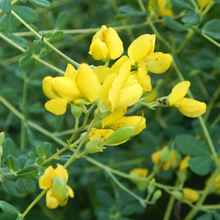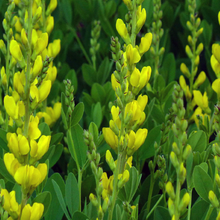Baptisia macrophylla 'Yellow' is a long lived perennial prized for its luminous yellow flower spikes that rise above bushy blue green foliage in early summer. Its sturdy stems and rounded form give it a shrub like presence, and its foliage remains attractive throughout the season. A member of the pea family, it enriches the soil by fixing nitrogen and is highly tolerant of drought once established.
Height & Spread: 36 - 48 in x 36 - 48 in
Bloom Time: Late spring to early summer
Light Requirements: Full sun
Soil Preference: Well drained, sandy or average soils
Watering Needs: Low; drought tolerant once established
Deer Resistance: Deer resistant
Native Status
This cultivar is derived from Baptisia species native to the central and eastern United States, and retains the ecological benefits of its native parentage in cultivated landscapes.
WILDLIFE & INSECTS
Butterflies
- Attracts nectar seeking butterflies including Eastern Tiger Swallowtail, Painted Lady, and Silver Spotted Skipper.
Bees
- Visited by native bumblebees, long horned bees, and leafcutter bees that are drawn to its bright flowers and abundant pollen.
Moths
- Serves as a host plant for moths such as the Wild Indigo Duskywing and Io Moth, which lay eggs on the foliage.
Birds
- Seed pods are occasionally foraged by seed eating birds like finches, and the dense plant structure offers nesting shelter.
Spacing & Landscape Use
Spacing Recommendations
- Space 36 - 48 in apart to allow for mature width and air circulation between plants.
Landscape Placement
- Excellent as a focal point in sunny perennial beds, meadow plantings, or mixed borders where structure, color, and pollinator support are priorities.
Companion Plants
- Salvia nemorosa 'Caradonna' (Wood Sage) - Provides a vertical accent of purple blue flower spikes that bloom in succession with Baptisia.
- Coreopsis verticillata 'Zagreb' (Threadleaf Coreopsis) - A compact, fine textured perennial with yellow blooms that echo and extend the color display.
- Amsonia hubrichtii (Arkansas Blue Star) - Adds soft texture and pale blue spring flowers followed by golden fall foliage.
- Echinacea purpurea (Purple Coneflower) - Adds midsummer color and strong wildlife support with its bold flowers and seed heads.
- Rudbeckia fulgida 'Goldsturm' (Black Eyed Susan) - Offers a bright continuation of yellow tones through late summer and attracts many pollinators.



